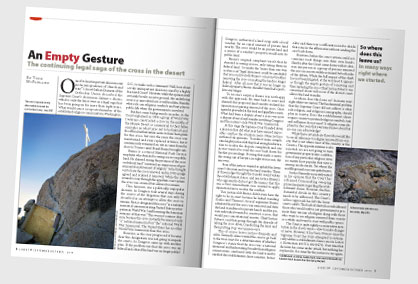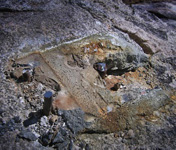An Empty Gesture
Todd R. McFarland September/October 2010
One of its least important decisions ever in the jurisprudence of ‘church and state’” is how Nathan Diament of the Orthodox Union described the Supreme Court’s decision in Salazar v. Buono, which is only the latest twist in a legal saga that has been going on for more than eight years. What would cause a respected member of the established religious community in Washington, D.C., to make such a statement? Well, how about a truly unimportant decision issued by a highly fractured Court? However, while the opinion itself certainly breaks no new ground, the underlying issue is as unresolved as it is well trodden. Namely, what role can religious symbols and text play in public life when the government is involved.
But first some background is in order. As the Court explained, in 1934 a group of World War I veterans constructed a cross in the middle of the Mojave Desert as a memorial to their fallen comrades on what turns out to be federal land. No official authorization seems to have been given for this cross, but over the years the cross was maintained and even replaced at times, but it continuously remained on site in some form for close to 70 years until Frank Buono brought suit.
Buono is a retired National Park Service employee who objected to seeing a cross on public land. He claimed seeing the presence of the cross on federal land “conveyed an impression of governmental endorsement of religion.” So he brought suit to have the cross removed, and in 2002 a judge agreed and ordered it removed. While the case wound its way through the appellate court system the cross was covered but allowed to remain.
This, however, was a politically unpopular decision. So Congress took several steps during the course of the litigation that can only be described as an attempt to allow the cross to remain. First, it designated this cross “as a national memorial commemorating United States participation in World War I and honoring the American veterans of that war.” This was not a minor decision, because this cross instantly became not only “a” national memorial but “the” national World War I memorial. The United States has no other World War I memorial than this cross.
However, as the case progressed it became clear this designation was not going to impede the courts. So Congress came up with another plan. If the problem was that the cross was on federal land, what if the land was no longer public? Congress authorized a land swap with a local rancher for an equal amount of private land nearby. The cross would be on private land and a corner of a rancher’s property would now be public land.
Buono’s original complaint wasn’t that he objected to seeing crosses, only seeing them on federal land. So under the “more than one way to skin a cat” legal doctrine it could be concluded that you could satisfy Buono’s concerns by either removing the cross or making the land no longer federal. After all, now that it was no longer on federal property Buono shouldn’t have had a problem any longer.
To no one’s surprise Buono was not happy with this approach. He went back to court and claimed this proposed land transfer violated his injunction requiring removal of the cross. Once again he prevailed at the trial and appellate courts. What had been a dispute about a cross was now a dispute about a land transfer involving Congress and the nation’s only World War I memorial.
At this stage the Supreme Court handed down a decision that did what may have seemed impossible: confuse the situation more. Nine justices authored six opinions. To make it more complicated eight justices felt they had enough information to resolve the dispute completely and one justice wanted to send the case back down for further proceedings. Proving that math is never the strong suit of lawyers, in eight versus one, the one won.
Four of the justices wanted to uphold the lower court’s decision and stop the land transfer. Three of those judges thought the transfer would violate the establishment clause, and one justice (Breyer), who apparently did not get this memo that this was a First Amendment case, wanted to apply injunction law to resolve the conflict.
Two justices felt Buono didn’t even have the right to be in court because he lacked standing (Scalia and Thomas). At oral argument Buono admitted that if the cross was removed and then the land transferred to private hands and the private individual wanted to construct a cross, that would pass constitutional muster. Chief Justice Roberts said that going through the charade of taking the cross down, transferring the land, and then putting it up was unnecessary.
This of course leaves justices Kennedy and Alito. Kennedy alone wanted the case to go back to the trial court for a determination of whether Congress’s stance that the cross was a national memorial and had meaning broader than religious connotations combined with the land transfer satisfied the establishment clause concerns. Justice Alito said there was a sufficient record to decide that issue in the affirmative without sending the case back down.

All that remains after the cross was stolen,
May 2010.However, before the court system could act, someone took things into their own hands. Shortly after the Court came down with its decision one person or a group of persons removed the cross in a move widely criticized by both sides of the debate. While the full impact of this theft has not been litigated, at the very least it appears as though the empty gesture of removing and then replacing the cross Chief Justice Roberts was concerned about will occur if the district court allows the land transfer.
So where does this leave us? In many ways right where we started. The fundamental problem that the Supreme Court did not address is what role religion, and religious iconography, should play in society. Does the establishment clause require society to pretend religious symbols, text and influence do not exist? Is religion some elephant in the room that everyone knows about but no one can acknowledge?
While there certainly are those who would like to see all references to religion removed from society, that is not where most of the country or the Court is. The opposite extreme is also rejected; we are not going to turn government property into a celebration of any particular religious view, no matter how popular that view is among an electorate. Yet where the middle ground is no one quite knows.
Justice Kennedy accurately noted in his opinion that the Court has refrained from making sweeping pronouncements regarding the establishment clause. However, the fundamental divide in this country needs to be addressed. The Court’s ad hoc approach has left the lower courts adrift. This lack of clarity has emboldened those who would seek to use government to promote their version of religion along with those who want to see religion removed from society as a whole and want to start with public spaces.
The Court is quite rightly a conservative institution in the classic sense—slow to make changes or move. However, it has been 39 years since the Supreme Court has truly attempted to systemically address establishment clause cases in Lemon v. Kurtzeman, 403 U.S. 602 (1971). Over time that decision has come under attack, but nothing has replaced it. It is time for the justices to try again.